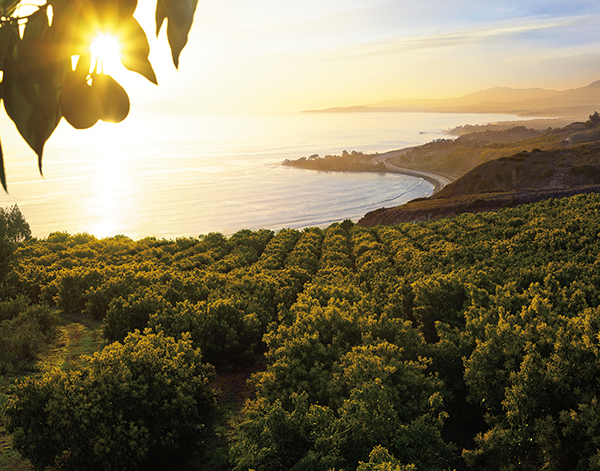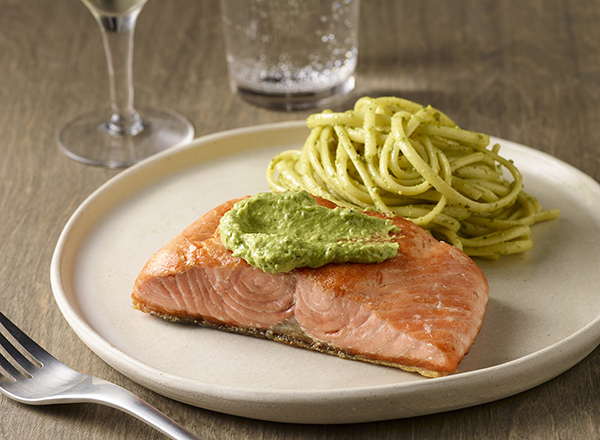With its mellow taste and rich texture, the California Avocado moves easily across dayparts and lends flavor and appeal to traditional, globally inspired and contemporary dishes. It’s a fruit (yes, a fruit!) that is familiar, yet full of untapped potential for culinary students and menu developers alike.
According to Datassential, two out of three consumers in the United States love avocados in guacamoles and salads 1. Residents in western states love the avocado more – 85 percent according to MenuMatters data2. Avocados are well worth exploring in many other application possibilities that can fulfill the latest trends and flavor profiles.
 All About Avocados
All About Avocados
There are nine avocado varieties commercially grown in California, but the Hass variety accounts for approximately 95 percent of the total crop volume. Lamb Hass and GEM are the next two most popular California Avocado varieties.
Today, California is the leading producer of domestic avocados and home to about 90 percent of the domestic crop. Most California Avocados are harvested on approximately 50,000 acres from Monterey through San Diego by about 3,000 growers. Ventura and San Diego top the list of avocado-producing counties in California with the area’s warm days and cooler coastal nights.
California Avocados are locally and sustainably grown by farmers who nurture the avocados and the land every step of the way to ensure that consumers can source high-quality avocados during the California Avocado season, which is from spring through early fall. They are committed to building and maintaining a sustainable industry by using environmentally friendly farming practices, ensuring worker well-being, contributing to healthy communities and maintaining economic viability.
Although cooks may see avocados in stores all year, it’s important to note that California Avocados are only in season from spring through summer/early fall, with the bulk of the fruit staying in the Western United States. All California Avocados should be labeled with a sticker or label of origin. Be sure to look for “California” on the avocado label to ensure you are getting fresh, domestically grown avocados when in season.
When are Avocados at Their Best?
It’s important to use avocados when they are at the ideal ripeness stage for the recipe. The size of an avocado does not indicate the fruit quality or stage of ripeness. An avocado’s seed grows with the fruit, therefore the seed-to-fruit ratio will always be close to the same.
The best way to tell if a California Avocado is ripe and ready for immediate use is to gently squeeze the fruit in the palm of your hand. Ripe, ready-to-eat fruit will be firm but will yield to gentle pressure.
Under- or overripe-fruit are great for certain applications, so avoid food waste and learn how to use them at each stage.
- Firm/Pre-Conditioned: Very hard, feels like an apple. Ripens in 5-7 days at room temperature (60°-70°F). Use for recipes where the firm flesh is an attribute, like Quick Pickled California Avocados or California Avocado Neapolitan Pizza.
- Breaking: Slightly soft, feels like an orange. Ready to eat in 2-5 days at room temperature (60°-70°F). Perfect for recipes where you want some chunky texture or are cooking the avocado, as in Greek Guacamole or Grilled Avocado with Peanut Salsa Macha.
- Ripe: Soft and yields to gentle pressure, feels like a ripe peach. Remains ripe for 2-3 days at room temperature or up to 5 days in refrigeration (36°-40°F). Use right away or freeze for up to one month. Mix in some acid like lime juice to help keep the fruit from oxidizing and turning an unappetizing brown. This stage is just right for those silky smooth soups and sauces like California Avocado Corn Chowder or California Avocado Aguachile
Teaching Avocados in the Classroom
Ready to learn all there is to know about cooking with California Avocados? The first step is to learn how to cut them safely—and avoid knife mishaps.
Complete the Free primer for Fresh California Avocados curriculum. Afterward, review the five in-classroom lab sessions that cover subjects like avocado yield, baking and nutrition, written by and for culinary educators to add to their classroom rotation.
Avocados and Menu Trends
When it comes to including avocados on menus, keep in mind that almost two-thirds of consumers in the West believe avocados are underutilized in restaurants3. This provides a ripe opportunity to surprise and delight customers with unexpected uses of an ingredient they already know and like.
Often, when you see California Avocados on menus, they are in savory dishes like guacamole, toasts or salads. But have you ever considered using them as an ingredient for baking or for sweet dishes?
California Avocados are known for their versatility, thanks to their soft texture and mild taste. This makes avocados the perfect creamy substitute for butter or shortening in baking4. California Avocados are a heart-healthy fruit which provide naturally good fats, are low in saturated fat and are cholesterol-, sodium- and trans-fat free.
When substituting avocados, a 1:1 ratio will work perfectly. Try them in vegan California Avocado Roti, for example, or Chocolate Avocado Pistachio Cake.
Consumers have an increasingly nuanced palate for the spices and complexity many Asian and South American dishes deliver and avocados fit well into several different cuisines.
- Moonbowls, a Korean restaurant in Chicago, serves a signature Avocado Bulgogi bowl with plant-based protein, avocado, kimchi and spicy sauce.
- Additionally, Thai restaurants like Luv ‘n Eat often have Avocado Green Curry on the menu, using chunks of slightly underripe avocado in place of or in addition to meat.
- Peruvian chefs traditionally use avocados in ceviche, sauces like aguachile and even a risotto-like Arroz con Cangrejo.
- Dishes with fermented ingredients are staples of the most popular cuisines, topping this year’s NRA Top 5 Dishes category 4. You can pickle avocados with a quick acidic marinade, as in Arroz con Cangrejo or use a longer fermentation, as in Lemon-Garlic-Rosemary Pickled Avocados.
Customers are increasingly gravitating to drinks with unique mouth feel and more complex tastes. Avocados contribute rich creaminess to drinks like smoothies and shakes. They can even replace some or all the dairy in a pureed beverage like California Avocado-Mango Cooler to make it reduced or lactose free. You can also use avocados in signature cocktails, as in this Hass Kicker Cocktail with jalapeno.
 You will soon learn California Avocados can be more than just mashed. They fit a wide range of trends, culinary needs, customer targets and nutrient goals. There is more inside a California Avocado than you think!
You will soon learn California Avocados can be more than just mashed. They fit a wide range of trends, culinary needs, customer targets and nutrient goals. There is more inside a California Avocado than you think!
About Jason Hernandez Chef Jason Hernandez is the former Corporate Executive Chef with Ascent Hospitality Management. He oversaw all culinary and beverage innovations for Perkins and Huddle House. In 2019, after 25+ years in culinary operations, Chef Jason launched Blade & Tine, a culinary consultancy designed to empower restaurant groups, independent operators and food brands with forward-thinking menu development and strategic culinary solutions.
Sources
1 Datassential, Avocado Forum 2024
2, 3 Menu Matters, “Patron Behavior and Attitude Study Among Western States” , July 2024
4, 5 NRA What’s Hot 2025
